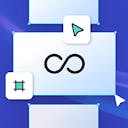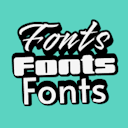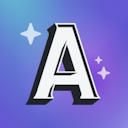Product
Templates
Resources
Company
Home
Blog
Design
Object typography: Turning letters into art
Object typography: Turning letters into art

The letters in the image above are AI-generated with Flux Pro 1.1 in Kittl
Have you noticed how typography is evolving? Letters are no longer just tools for communication—they’re expressive art forms in their own right. What we're talking about here is text that takes the form of physical objects—often called "object typography" or "typographic illustration."
Lately, AI image generators have allowed creators to shift typography from something we read to something we experience. Designers are pushing the boundaries of text, turning letters into lifelike visuals that live beyond the page. Whether it’s abstract forms, clean image-masked shapes, or even food—yes, food—text is being reimagined as a tangible, immersive object.
Table of contents
Object typography
Traditionally, typography existed to deliver a message. But now, type is the message. When we begin to treat letters as physical objects, their role transforms—they’re no longer just carriers of content but are content themselves.
Object Typography is a design technique where letters are treated as physical objects, transforming type into a visual, sculptural element.
This approach invites a deeper, more layered visual language. The transformation of text into object—and vice versa—allows for storytelling that’s not just informative but emotional, symbolic, and sensory.
While this style isn’t new, it’s undergoing a level-up. Thanks to AI tools and evolving software, what was once limited by manual techniques is now infinitely scalable and more accessible. Designers are no longer bound by what they can physically construct—they can dream bigger, and AI helps bring those visions to life.
Food typography
Before the latest AI advancements, designers used real-world materials to craft their type. Later, tools such as 3D rendering software stepped into the scene. A standout design choice from that era? Food typography.
Food Typography is a creative design style where food items are used to form letters and words, turning text into hyperrealistic and edible looking art. This approach blends visual appeal with sensory experience, using real-world materials to convey messages in a playful and impactful way.
Between 2016 and 2019, it gained traction as a popular design trend.
We shared our favorite examples of food typography on Instagram in the post below:
One specific example is an image from 2013, where the artist used actual french toast to spell out part of the message. This method was tactile, playful, and very human. And while AI may now offer endless creative freedom, the charm of physical, material-based typography still holds a place in the design world—so don't write it off just because AI stepped into the scene.

Why use food typography and object typography?
Because the impact is immediate. When letters physically represent the product or concept, the message isn’t just seen—it’s felt. This is especially powerful in branding and marketing, where every detail needs to resonate.
Let’s view a word on its own in simple type: “Yum.”
Now imagine the visual: Melting chocolatey mocha swirls in a silky form that spells “yum.” The message becomes immersive, merging type and imagery. This is exactly what Pantone did in their video announcement of the 2025 Pantone color of the year
By merging imagery and type into a unified element, brands can create something that’s more than marketing—it’s storytelling in 3D. And this is where AI image generators can play a major role.
AI-generated typography
With the help of AI, type is becoming something that not only tells a story but is the story. Today, designers can generate typographic visuals that feel alive—textured, dimensional, fluid. AI-image generators can enable you to create typopgraphy that embodies materials and even movement, offering a deeper, more dynamic connection between brand and audience.
Take the example image below:
Imagine this woven into an ad for a skincare brand whose identity is rooted in sustainability and natural materials. Their brand name (or hero text) isn’t just written—it’s alive and represents the honey-smooth texture of the product itself.
Without saying a word, the brand’s values of purity and skin-nourishing care are immediately clear.
The image in the example above was generated with Flux 1.1 Pro in Kittl. Try experimenting with your own ideas and create object typography in Kittl via the button below!
This is the power of AI-generated type: it bridges emotion, senses, and design. It takes brand values and distills them into a single, impactful visual moment.
With this approach, designers can integrate the very essence of the brand into the typography.
Text in motion
This form of 3D, hyperreal typography isn’t limited to digital stills. It's now showing up across video, advertising, and editorial design. One standout example? The MustardxMustard Super Bowl commercial in 2025, which turned static copy into a realistic, dynamic representation of the product, as the words were spelt out with actual mustard.

It raises an exciting question: What if the logo was the product?
What if the logo was the product?
One designer recently explored this concept by blending logo design and product visuals into a single, inseparable identity. This creator, Eslam Mhd, explored what the iconic McDonald's logo would look like if it was the product synonymous with the brand—the Big Mac.
Change the style of an image or logo with one click
To make ideas like this a reality, designers are turning to tools that allow them to shift visual styles with speed and ease.
With Image Restyle in Kittl, you can apply fresh visual styles to your images, text, logos, and even entire layouts in just a few clicks. It opens up new creative directions without needing to rebuild a design from scratch. Whether you're refining a campaign or experimenting with early-stage concepts, it gives you more space to play—and more time to focus on the vision.
See Image Restyle in action below:
This level of creative flexibility is becoming essential. As brands look to connect on deeper levels, tools like this aren’t just useful—they’re redefining the design process.
No matter the scale of the project, AI image restyling helps breathe new life into your visuals while keeping your workflow efficient and agile.
Key takeaway
What we’re seeing now is just the beginning. Object typography is more than a design choice—it’s a way you can add emotional depth, brand storytelling, and creative experimentation to your projects. AI-generated typography is a tool to enhance human creativity, extending our ability to communicate ideas in richer, more nuanced ways.
And type is no longer just words or an added design element—it’s your key to level-up branding, storytelling, and visual communication.
Related articles

Tutorials
Writing AI Prompts: Tips & Tricks for Creatives
AI tools are becoming common companions in creative industries. Artists, print-on-demand creators, g...

News
Eraser just got that magical touch: AI Erase & Fill!
Ever had the perfect image, except for one pesky object? Tried generating something new, re-working ...

Inspiration
Font pairing 101: The ultimate guide to choosing the perfect fonts
Ever noticed how some designs just feel right, while others seem off, even if you can’t quite put yo...
















